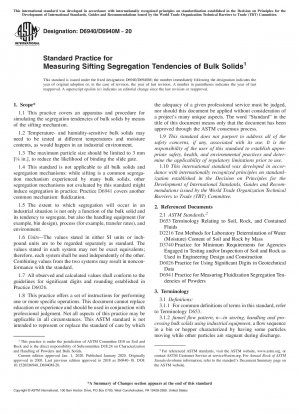ASTM D6940/D6940M-20
Standard Practice for Measuring Sifting Segregation Tendencies of Bulk Solids
- Standard No.
- ASTM D6940/D6940M-20
- Release Date
- 2020
- Published By
- American Society for Testing and Materials (ASTM)
- Latest
- ASTM D6940/D6940M-20
- Scope
- 1.1 This practice covers an apparatus and procedure for simulating the segregation tendencies of bulk solids by means of the sifting mechanism. 1.2 Temperatureand humidity-sensitive bulk solids may need to be tested at different temperatures and moisture contents, as would happen in an industrial environment. 1.3 The maximum particle size should be limited to 3 mm [1⁄8 in.], to reduce the likelihood of binding the slide gate. 1.4 This standard is not applicable to all bulk solids and segregation mechanisms: while sifting is a common segregation mechanism experienced by many bulk solids, other segregation mechanisms not evaluated by this standard might induce segregation in practice. Practice D6941 covers another common mechanism: fluidization. 1.5 The extent to which segregation will occur in an industrial situation is not only a function of the bulk solid and its tendency to segregate, but also the handling equipment (for example, bin design), process (for example, transfer rates), and environment. 1.6 Units—The values stated in either SI units or inchpound units are to be regarded separately as standard. The values stated in each system may not be exact equivalents; therefore, each system shall be used independently of the other. Combining values from the two systems may result in nonconformance with the standard. 1.7 All observed and calculated values shall conform to the guidelines for significant digits and rounding established in Practice D6026. 1.8 This practice offers a set of instructions for performing one or more specific operations. This document cannot replace education or experience and should be used in conjunction with professional judgment. Not all aspects of this practice may be applicable in all circumstances. This ASTM standard is not intended to represent or replace the standard of care by which the adequacy of a given professional service must be judged, nor should this document be applied without consideration of a project’s many unique aspects. The word “Standard” in the title of this document means only that the document has been approved through the ASTM consensus process. 1.9 This standard does not purport to address all of the safety concerns, if any, associated with its use. It is the responsibility of the user of this standard to establish appropriate safety, health, and environmental practices and determine the applicability of regulatory limitations prior to use. 1.10 This international standard was developed in accordance with internationally recognized principles on standardization established in the Decision on Principles for the Development of International Standards, Guides and Recommendations issued by the World Trade Organization Technical Barriers to Trade (TBT) Committee.
ASTM D6940/D6940M-20 Referenced Document
- ASTM D2216 Standard Test Method for Laboratory Determination of Water (Moisture) Content of Soil and Rock by Mass
- ASTM D3740 Standard Practice for Minimum Requirements for Agencies Engaged in the Testing and/or Inspection of Soil and Rock as Used in Engineering Design and Construction
- ASTM D6026 Standard Practice for Using Significant Digits in Geotechnical Data
- ASTM D653 Standard Terminology Relating to Soil, Rock, and Contained Fluids
- ASTM D6941 Standard Practice for Measuring Fluidization Segregation Tendencies of Powders
ASTM D6940/D6940M-20 history
- 2020 ASTM D6940/D6940M-20 Standard Practice for Measuring Sifting Segregation Tendencies of Bulk Solids
- 2018 ASTM D6940-18 Standard Practice for Measuring Sifting Segregation Tendencies of Bulk Solids
- 2010 ASTM D6940-10 Standard Practice for Measuring Sifting Segregation Tendencies of Bulk Solids
- 2004 ASTM D6940-04 Standard Practice for Measuring Sifting Segregation Tendencies of Bulk Solids
- 2003 ASTM D6940-03 Standard Practice for Measuring Sifting Segregation Tendencies of Bulk Solids
